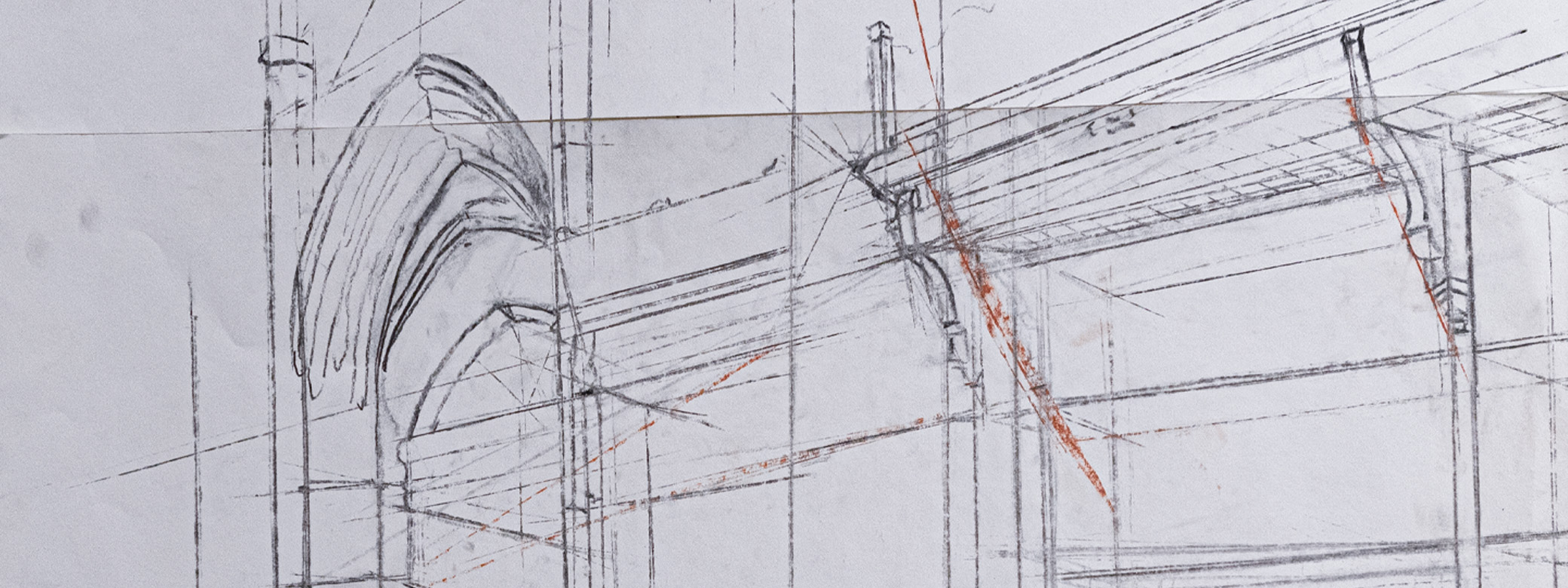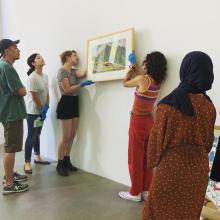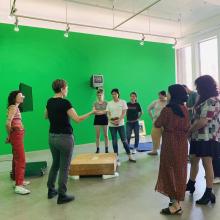Each summer quarter, students gather for a class titled Curating Contemporary Art, a Jacob Lawrence Gallery Practicum (ART 496 / ART H 498). Some of the students go on to work as paid interns in the gallery during the following academic year.
The class has been virtual in 2020 and 2021, but it has continued to provide students with an overview of the multifaceted world of contemporary art. Jacob Lawrence Gallery Director + Curator Emily Zimmerman wrote this in her most recent course description:
This class examines the theory and practice of curating exhibitions of contemporary art. We will look at exhibitions as a vehicle for the reception of art, philosophies of aesthetic experience, knowledge production, cultural politics, and social engagement. The class will study curatorial methodologies, historical exhibition formats, key watershed exhibitions that changed the curatorial practice, as well as the practical skills associated with realizing an exhibition. Guest curators and cultural producers will join the class to speak to their practice in relation to the larger cultural field.
We invited a few of the students from this summer's class to write about their experience.
Alexander Betz
I am a senior majoring in Biochemistry, Art History, and Classical Studies. I took this course because I am interested in the intersection of art with the viewer. This understanding blossomed throughout the course into a wide-ranging appreciation of the many ways that the curatorial role engages with the public and the arts. In particular, I was surprised by the level of conscious thought and attention this course paid to issues of social justice and equitable access. Some of my favorite lessons were those that dealt with the history of the curatorial field because they helped me to contextualize the progress that still needs to be made in terms of removing bias and prejudice from institutions. Topics within this vein of the class dealt with issues like how to create and design inclusive shows that respect and acknowledge historically over-looked groups and peoples. With this in mind, going forward I think that the most important lesson that I gained from this course was to take the time to fully recognize the responsibilities and impacts of any given role. I came to recognize the power that comes with being a curator, where a fully realized individual in that position can be the bridge between the public and the essential creative forces of a diverse range of peoples. I want to take this understanding forward, and do my best to recognize the potential and responsibility in the roles that I hold. For example, within this particular course I exercised this understanding by producing an exhibition recognizing and celebrating artists from many different and often over-looked identities through the Pacific Northwest. Having grown up in this region, I found this project to be a personally moving experience which made me get in touch with the many different stories within my home that, while much different to mine, still remain an essential part of my community. This is what I appreciated most about this course. Curating is about being thoughtful and making sure that important shareholders of a story are not overlooked and forgotten about. This course took strides throughout the quarter to cover the many different currents that flow into the production of an exhibition, resulting in an academic atmosphere expressly interested in uncovering and respecting the multitude of parts that construct a whole. Looking forward, I plan to use what I learned in this course by interning with the Jacob Lawrence Gallery and applying my experience in person. I am thankful for the doors that this class has opened for me, and I would recommend it to anyone even if they are not interested in becoming a curator.
Amelia Ketzel
I am majoring in Art History and Classical Studies, and I chose to take this class because I am passionate about museums and arts institutions. I saw ART H 496 as a great opportunity to expand my knowledge about the field of curation and possible future career paths. My entire work experience has been in museums — I have been a volunteer, an intern, an employee, but I had never really been formally introduced to the technicalities and everyday details of many museum jobs.
I think many museum roles and arts-related jobs aren’t commonly talked about yet require a very specific set of skills and experience. Besides stalking job postings on museum websites, information about how to actually break into the art world isn’t often accessible or readily available. Yet this type of practical knowledge is eventually expected and extremely necessary to finding a job or career path after college. I think many people want to find curatorial work or jobs within museums or arts institutions, but the abstract thinking and theoretical skills often taught in college classes don’t directly equip an individual for a post-college job and do not easily translate to marketable job skills one can put on a resume. While the critical thinking skills and subject-specific knowledge classes offer is extremely important from an intellectual standpoint, often little attention is given to teaching students important skills that museums want from prospective employees. This class in many ways filled that gap, teaching students how to seriously approach the curatorial field as well as other museum roles. Technical skills were taught (hanging works, documentation, an introduction to the actual organization of shows) but, most importantly, students were taught how to prepare for what was expected from the role of curator.
ART H 496 introduced the field of curation as if participants were training to be curators themselves. The class not only ran through the ins and outs of curatorial work but got down to the everyday minutia of curation and what is actually expected of a curator in their day-to-day lives: paperwork, the process of exhibition design, public programming, best practices and ethics, etc. It was far more serious and comprehensive than what I expected — students were treated seriously and information wasn’t withheld and nothing was dismissed. ART H 496 laid down an understandable idea of what curatorial work is, what is expected of a curator, and possible paths to one becoming a curator themselves. It was a crash course on a very specific career path that often feels secretive and exclusive.
After ART H 496, I not only feel as though I have a good vision of what curation is but am now equipped with the ability to articulate and identify my specific goals and the steps I need to achieve them. Before the summer, I lacked a concrete idea of how one came to be a curator (finish college, gain experience?), (middle steps?)) but my best takeaway from ART H 496 is the ability to plot and articulate a concrete path for my future.
Behnaz Monzavi
Painting + drawing is my major. This class appealed to me for a variety of reasons. One was that I had previously spent two years working in a college art gallery. I was curious to see how the working structure functions in larger galleries. I also wanted to see the exhibition process as a painter. During the epidemic, the concepts I acquired in this class were fascinating to me because I wanted to know how exhibitions would be held during this time period. Installing 3D works, art insurance, and other important topics were covered in this lesson. I'd like to use what I've learned in the future to further my artistic career and organize exhibitions.
Laku Nagami
I am currently an Art major at the University of Washington. I chose to take the Jacob Lawrence Gallery curatorial internship because I was intrigued by the curatorial process and how art was managed in an exhibition environment. This 400-level class provided a unique opportunity to connect with professional curators who spoke about their experiences on how one imagines a show that can speak to the audiences’ hearts.
An aspect of ART496 that surprised me was the amount of detail and thus background checks that were taken into consideration when preparing an exhibition. A work of art can possess a multitude of different meanings. For example, while one may argue for its progressive vernacular, others may frown upon the work’s cultural insensitivity. As a curator, finding the piece that adheres to their concept is important, but they must also consider its origins and intent; one should understand the responsibility of representing a piece of culture under an umbrella theme. Therefore, while planning an exhibition the curator must do extensive research on the work they will be handling.
Likewise, the most valuable piece of knowledge I acquired in this internship was regarding the importance of research within the curatorial field. Once again, curation is a process where trust is at the forefront. Every minor detail must be communicated and therefore the curator must know exactly what they are talking about. The venue, time, work integrity, transportation process, environment, insurance, and much more need to be carefully considered before the artist is contacted. The internship allowed me to reacknowledge the importance of this process and how a successful exhibition starts with a deep understanding of the topic.
I plan to use what I have learned throughout ART 496 in a variety of settings that include preparation and research. I do not plan on hosting an exhibition of my own currently, but I am interested in fields such as production and project management which require extensive research, while also being creative. Similarly, when curating a portfolio, I will be able to find a central theme within my compositions and narrate a story, which most often does not get prioritized within a technique-driven portfolio.
The experience during the ART496 curatorial internship was a unique and intriguing one but requires the individual to care and be willing to learn about the topic. I enjoyed learning from Ms. Zimmerman, and I would highly recommend taking the class, if the path of curation is a consideration.


